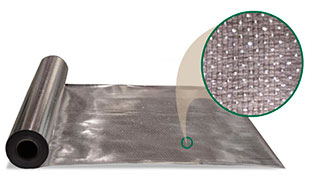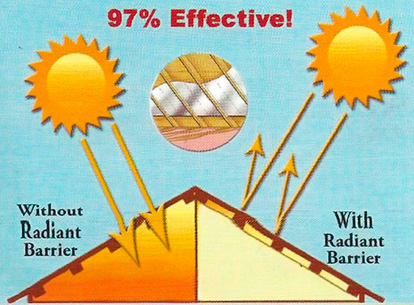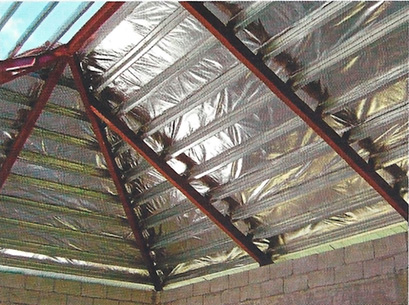Radiant Barrier Foil Heat Insulation
What is Radiant Barrier Heat Insulation?
Radiant barrier insulation is a reflective insulation system that offers a permanent way to reduce heat. Radiant barrier insulation reflects radiant heat energy instead of trying to absorb it. It consists of a pure aluminized film which is unaffected by humidity and will continue to perform at a consistent level no matter how humid it may be. This is not kitchen foil (kitchen foil is only about 20% aluminum; this is 99.5% pure aluminum).
Most people are familiar with traditional insulating materials such as fibreglass, Styrofoam and rock wool. These products use their ability to absorb or resist (slow down) convective and conducive heat transfer to insulate (R-value). A third seldom discussed but dominant form of heat transfer that exists is: RADIANT HEAT TRANSFER.
A radiant barrier insulation reflects radiant heat energy instead of trying to absorb it. There are two properties on which radiant barrier works: Reflectivity and Emissivity. First, the aluminum is reflective on the hot side, reflecting most of the heat from where it came. Second and most important, aluminum has a low emissivity of between 0.03 and 0.05. This means that only 2% of the heat is emitted to the inside of the building.
Benefits of Radiant Barrier Foil Heat Insulation
- Reflects 98% of radiant heat
- Class A / Class 1 Fire Rating
- Non-toxic / Non-Carcinogenic
- Does not require protective clothing to install
- Cost effective
- Durable and lightweight
- Not affected by moisture or humidity
- Easy to install and maintenance free
- Lowers electricity cost (when A/C is in use)
- This product pays for itself
- When the sun heats a radiant barrier, it does not penetrate the reflective surface.
Common Questions about Radiant Barrier Foil Heat Insulation
- How does it work?
Answer: It is a radiant reflector. Unlike many insulations which slow down heat transfer it reflects heat. To stop radiant heat you must reflect it with a radiant barrier.
- Where do you install it?
Answer: Over your roof purlins like a blanket or stapled under your wooden rafters and in your attic spaces.
- How can it keep heat out?
Answer: Radiant barrier reflects the sun’s heat before it can warm up the space in your attic. It may help to understand if you think of other materials that perform the same way; ASTRONAUTS SPACE SUIT - keep body heat in and reflect the sun’s heat away.
- Has radiant barrier heat insulation been tested by a qualified independent laboratory?
Answer: The Florida Solar Energy Center at Cape Canaveral has tested radiant barrier in both small scale laboratories and in full scale building models. Their results indicate that it has provided significant resistance to heat transfer.
- Can radiant barrier insulation save me money?
Answer: Yes, if the floor below the roof is being air conditioned. Radiant Barrier reduces the amount of heat entering into the building causing the A/C condenser to work on shorter cycles and therefore saving money on electricity. Over time these savings will repay the cost of having the radiant barrier.
Product Specifications
United States Testing Company Inc.
|
Product Description |
Two-sided reflecting metalized film with polyethylene woven reinforcement |
|
Weight: |
14.75 lbs per 500 sq ft roll or 29.5 lbs per 1,000 sq ft roll |
|
Tensile/Tear Strength |
Length: 13.23 pounds force Width: 13.98 pounds force ASTM D2261 |
|
Pliability |
70°F±5°F & 50±5% Relative Humidity – No Cracking or Delamination ASTM C1313-05 |
|
Adhesive Performance |
180°F±5°F & 50% Relative Humidity – No Bleeding or Delamination ASTM C1313-05 |
|
Flame Spread & Smoke |
Class A/ Class 1 0 Flame Spread, 5 Smoke Development ASTM Method E84-10 |
|
Resistance to Fungi |
PASS – No Growth ASTM C1338-08 |
|
Permiability |
6.29 Perms ASTM E96-05 |
|
Thermal Properties |
EMISSIVITY: 0.05 REFLECTIVITY: 95% ASTM C1371-04a |



